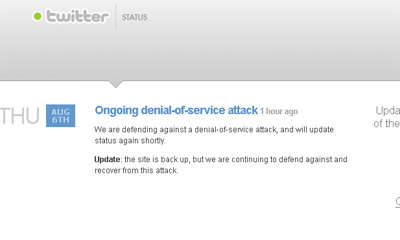Twitter and Facebook are under attack today.

Way back when, Twitter outages were so commonplace that it was worth reporting when it didn’t crash–as when it stayed afloat during the entire South by Southwest Interactive Festival in 2008. Now, a few million dollars of venture capital later, the service is far more stable.
Twitter wants to establish itself as a communications standard rather than just a social-media brand. It’s been a crucial platform for information exchange in the face of global events where more traditional means of broadcasting have been inaccessible or blocked.
Some features of Facebook were also experiencing uptime issues on Thursday–one reader speculated that log-in servers may have been down–which raises the issue of whether a hosting company problem is to blame. Alternately, a denial-of-service attack could have been targeting both high-profile companies.
Facebook is “looking into” the outages, spokeswoman Brandee Barker said in an e-mail.
In the big scheme of thing, perhaps, it’s not that big of a deal. After all, I’ll live if I don’t know you’re having ham-and-cheese for lunch.
Earlier this week, some popular sites were also under attack.
Last month, AT&T’s network was also attacked.
But coming on the heels of a denial-of-service attack, allegedly by North Korea, a month ago, we might be missing the big picture here. Yes, we’re dependent on social media for, possibly, a bigger part of our day than it should occupy. But we’re dependent on the Internet and its infrastructure for far more important things, too.
Is it up to the task? Are the same people responsible? Is this the start of something bigger?
Why feds can’t stop cyberattacks, on FederalTimes.com was a sobering read.
“For the most part, a more modern infrastructure is an almost complete protection against these attacks,” said Mark Pietrasanta, the chief technology officer at Aquilent, a Maryland-based IT firm that does Web development for numerous federal agencies. “And we know a couple of the agencies [that were affected] do not have real modern infrastructure for their Web sites. It’s analogous to running a Web site on a computer under someone’s desk.”
Maybe it’s time to push the cybersecurity issue up a bit higher than, say, color-coded threat charts.
I’m having soup for lunch, by the way.
